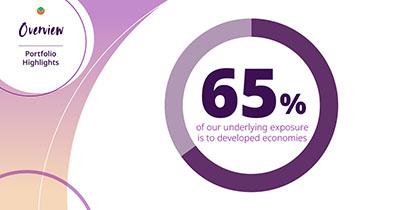How We Invest
Driven by our views of the trends shaping societies, we invest today with tomorrow in mind.
Jump to
We aim to build a forward looking and resilient portfolio that delivers sustainable returns over the long term. We deploy capital to catalyse solutions that can enable the transition to a low carbon economy, and tap on opportunities to build future growth sectors and leading enterprises through our efforts in innovation. Our investment activities are aligned to four structural trends that shape our long term portfolio construction.
Digitisation and Sustainable Living are megatrends with a pervasive impact across many sectors as well as on the business models of emerging and established businesses. Future of Consumption and Longer Lifespans reflect structural shifts in consumption patterns and growing needs of longevity arising from our population growth and longer expected lifespans. These trends are interconnected, transcend sectors and countries, and continue through economic cycles.
We expect to increasingly align our portfolio with such trends. This includes investing into companies that directly enable and drive these trends, as well as those that harness the potential of the trends for growth. We back innovations and technologies at pre-commercialised stages to be at the leading edge in relevant areas of Artificial Intelligence, Blockchain, Cyber and Deep Tech. In addition, we engage closely with our portfolio companies on their efforts in assessing potential disruption risks and identifying transformation opportunities arising from these trends.
We evaluate sustainability-related risks and identify opportunities in investments through our Environmental, Social and Governance framework, which also supports our target to halve the net carbon emissions of our portfolio over 2010 levels by 2030, and our ambition to achieve net zero carbon emissions by 2050.
We deploy capital to catalyse solutions that can enable the transition to a low carbon economy.
A safe and supportive working environment, jobs that pay a fair wage, and diverse and inclusive workplaces are foundational to resilient communities, especially as the transition to low carbon and digital economies bring about fundamental changes to businesses and jobs. As economies reposition themselves for growth in new sectors, we encourage companies to help their workers upskill and reskill to stay relevant and employable.
Strong corporate governance, which includes the purpose of a company and the values of its people, helps sustain a committed workforce. The composition of its boards of directors, the rights of shareholders, the interests of stakeholders, and the balance between short term and long term performance measurements are all important to ensuring strong corporate governance and helping to underpin resilient institutions.
Our investment discipline is centred around intrinsic value and our risk-return framework. This framework forms the basis of our investment decisions, capital allocation, performance measurement and incentive system.
For each investment we make, we conduct bottom-up intrinsic value analysis, with expected returns evaluated against a risk-adjusted cost of capital that is derived using the capital asset pricing model. To begin with, each investment’s risk-adjusted cost of capital is based on its industry risk, debt-equity ratio and country risk. Investments in riskier sectors or markets will have higher costs of capital.
We then add an illiquidity risk premium for unlisted investments and a venture risk premium for early stage investments. We use risk-adjusted cost of capital to normalise the risks in order to compare the relative attractiveness among investment opportunities.
We also factor in an internal carbon price of US$50 per tonne of carbon dioxide equivalent (tCO2e), to assess the possible climate transition impact and to further guide our investment decisions. We expect to increase this to US$100 by the end of this decade. This allows us to better evaluate the long term value of our portfolio, adjusted amongst other things, for the confluence of future carbon taxes and levies as well as the potential increase in financial costs arising from the pace of mitigation, adaptation, and transition.
At a portfolio level, we have full discretion as an owner and investor to reshape and rebalance our investment holdings as the situation warrants. From time to time, we may express interest to invest or divest selected positions based on our outlook and risk-return appetite. We may take concentrated positions, remain in cash, and/or use derivatives to hedge currency or protect against potential losses of our underlying investments. Our investments are predominantly in equities. We do not have targets for investing by asset class, country, sector or single name. We manage our liquidity and balance sheet for resilience.
Our portfolio comprises both listed and unlisted assets, including investments in funds. The unlisted portfolio has grown steadily over the years as we invested in attractive opportunities in the private markets and benefitted from the increase in the value of our unlisted assets.
We value our unlisted investments at book value less impairment. Marking them to market will provide about 10% value uplift on our unlisted portfolio as at 31 March 2022.
We have full discretion as an owner and investor to reshape and rebalance our investment holdings as the situation warrants.
Over the last decade, our unlisted portfolio generated returns of over 10% per annum, delivering an illiquidity premium. Our unlisted returns include the returns when our unlisted investments are listed or sold, as well as from the strong performance of the underlying companies.
Our unlisted portfolio generated returns of over 10% per annum, delivering an illiquidity premium.
Our unlisted portfolio offers us liquidity in the form of steady dividends from mature companies and distributions from the high quality portfolio of funds we have built up over the years. The funds are well diversified across geographies, sectors and vintages. In addition, we can access liquidity by divesting our unlisted holdings.
Our unlisted portfolio generated returns of over 10% per annum, delivering an illiquidity premium.
(as at 31 March 2022)
Unlisted Portfolio (%)
- Singapore companies
- Asset management businesses
- Private equity and credit funds
- Other private companies
(including early stage)
Unlisted Singapore companies constitute just over a third of our unlisted portfolio and include mature companies such as Mapletree, PSA and SP Group.
We have expanded and scaled our asset management business which was initially conceived to catalyse Singapore’s asset management ecosystem. It is currently about one fifth of our unlisted portfolio, and includes companies such as Vertex Holdings and Seviora Holdings, which comprises four companies owned by, or affiliated with, Temasek – namely Azalea Investment Management, Fullerton Fund Management, InnoVen Capital, and Seatown Holdings International.
Investments in private equity and credit funds have been instrumental in helping us gain deeper insights into new markets or sub-sectors of specialisation and have provided co-investment opportunities. These funds make up slightly less than one fifth of our unlisted portfolio.
Our investments into other private companies such as Ant Group, Ceva Santé Animale, Global Healthcare Exchange, Schneider Electric India Private Limited, Topsoe, Verily Life Sciences, A.S. Watson and WuXi AppTec, make up about a quarter of our unlisted portfolio. Some of these private companies are early stage companies. Through these investments, we gain insights into innovation in technology and business models, which enable us to better assess future opportunities and segments, as well as better understand potential implications for our broader portfolio. Our early stage investments are diversified across geographies and sectors. These early stage companies have the potential to achieve significant growth over time and deliver attractive risk-adjusted returns. Several of these companies have matured from early stage. Early stage companies make up less than 10% of our unlisted portfolio today.
As an active and engaged shareholder, we seek to add value to our portfolio companies across all stages of growth, from early stage to mature enterprises. We established the Portfolio Development Group to work together with our major portfolio companies to enhance value through partnerships, innovation, growth strategies and transformational possibilities.
We seek to add value to our portfolio companies across all stages of growth, from early stage to mature enterprises.
We proactively promote good governance, looking to boards to drive strategy and oversee management, who, in turn, run their respective companies.


